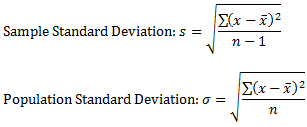

Few, if any, of the values in a sample (or a population) actually equal the mean value. These values are said to deviate from the mean (which simply means they are different from the mean). The deviation of any given value is the difference between the given value and the mean:
![]()
Geometrically, the deviation is the directed distance from the mean to the given value. Values greater than the mean have a positive deviation while values less than the mean have a negative deviation. The goal is to find a single descriptive statistic that summarizes the set of deviations for all of the data values. One might be tempted to find the average deviation but, unfortunately, this will not work. The sum of the deviations (and, consequently, the average deviation) is always zero since the positive and negative deviations cancel each other out.
To get around this problem, the deviations are squared because the square of a number is always positive. The population standard deviation is the square root of the average of the squares of the deviations. The sample standard deviation is similar except that the sum of the squares is divided by n-1 rather than n:
